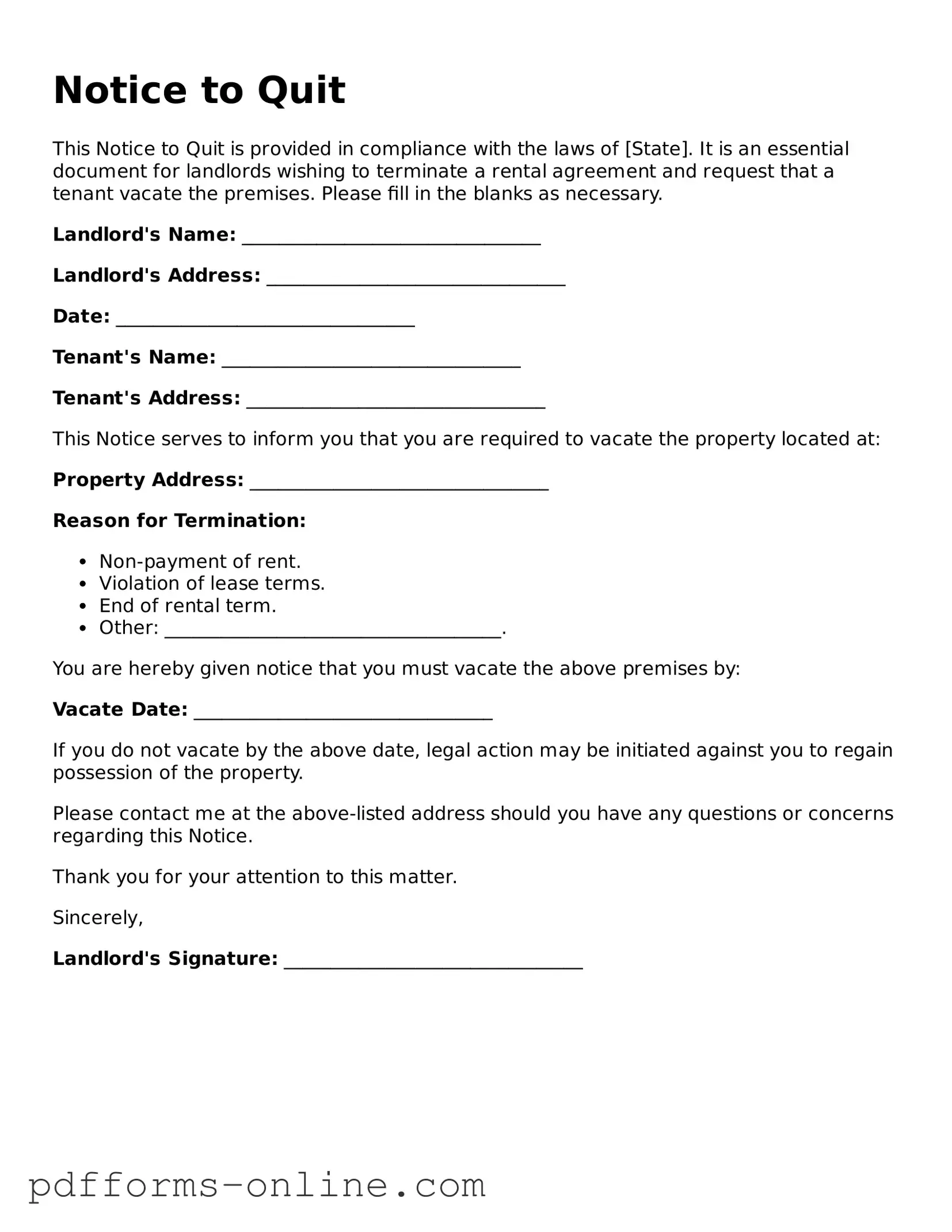The Notice to Quit form is similar to a Lease Termination Notice. This document is used by landlords or tenants to formally end a lease agreement. Just like the Notice to Quit, the Lease Termination Notice outlines the intent to terminate the lease, providing a specific date by which the tenant must vacate the premises. Both documents serve as a formal communication to ensure that all parties are aware of the termination timeline.
Another document that shares similarities with the Notice to Quit is the Eviction Notice. This notice is typically issued when a tenant has violated lease terms, such as failing to pay rent. While the Notice to Quit may be used for various reasons, the Eviction Notice is more specific and often indicates that legal action may follow if the tenant does not comply. Both documents aim to inform tenants about their obligations and the consequences of not adhering to them.
The Rent Demand Notice is another related document. This notice is sent to tenants who have not paid their rent on time. It serves as a formal request for payment, similar to how a Notice to Quit requests that a tenant vacate the property. Both documents are important tools for landlords to communicate issues regarding tenancy and to encourage compliance before taking further action.
A Cure or Quit Notice also bears resemblance to the Notice to Quit. This document is issued when a tenant has breached a lease term but can rectify the situation, such as fixing a maintenance issue. The Cure or Quit Notice gives the tenant a chance to correct the problem, while the Notice to Quit simply demands that the tenant leave. Both documents emphasize the importance of adhering to lease agreements.
The Notice of Non-Renewal is similar in that it communicates the end of a rental agreement. Landlords use this document to inform tenants that their lease will not be renewed at the end of the term. Like the Notice to Quit, it provides a clear timeline for the tenant to prepare for moving out, ensuring that all parties are on the same page regarding the lease's conclusion.
Additionally, the Notice of Lease Violation is akin to the Notice to Quit. This document is issued when a tenant fails to comply with specific lease provisions. It details the violation and often gives the tenant a chance to correct the issue. Both notices serve to inform tenants of their responsibilities and the potential consequences of failing to meet those obligations.
The 30-Day Notice is another document that aligns with the Notice to Quit. This notice is commonly used in month-to-month rental agreements to inform tenants that their tenancy will end in 30 days. Like the Notice to Quit, it provides a clear deadline for vacating the property, ensuring that tenants have adequate time to make arrangements for their move.
The Notice to Pay Rent or Quit is also similar. This document is issued when a tenant has not paid their rent. It demands payment within a specific timeframe or states that the tenant must vacate the property. Both notices serve to address issues of non-payment and outline the next steps if the tenant fails to comply.
For landlords and tenants navigating the complexities of rental agreements, understanding various legal documents is essential. One such document is the All Arizona Forms, which provides crucial insights into agreements that could impact business relationships beyond rental situations. Familiarity with these forms, along with eviction notices and breaches, helps clarify responsibilities and rights in the landlord-tenant dynamic, ensuring compliance and minimizing disputes.
Finally, the Termination of Tenancy Notice is comparable to the Notice to Quit. This document is used to formally end a tenancy, whether due to lease expiration or other reasons. It provides tenants with information about their rights and responsibilities as they prepare to leave the property. Both documents aim to clarify the end of the rental relationship and ensure a smooth transition for all parties involved.
